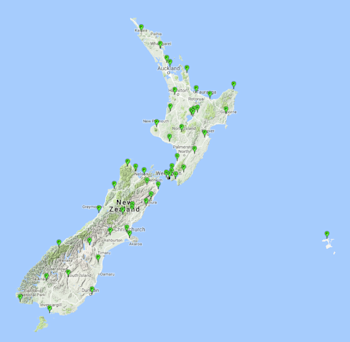
LINZ PositioNZ-RT streaming latencies reduced up to 90%! Just in time for Christmas.
GeoNet runs the PositioNZ network of Continuously Operating GNSS/GPS Reference Stations on behalf of Land Information New Zealand (LINZ), and the real-time streaming of data from these stations just became a whole lot faster!
The PositioNZ network we operate on behalf of LINZ comprises 37 GNSS (Global Navigational Satellite Systems, e.g. GPS) sites spread across New Zealand and one in Antarctica. Each of these sites, as well as 15 additional GNSS sites provided by GeoNet, provide a stream of their data through the LINZ PositioNZ Real Time service. The approximate location of each of the sites is shown in the map below.
Each GNSS site available through the PositioNZ-RT service provides a stream of observations made every second. These streams provide a means to locate oneself using geodetic survey equipment to within a few centimetres, either while stationary or on the move.
One common use of these streams is for real-time positioning, which is very useful for land surveyors, engineers, and the infrastructure and transportation industries. Even while one moves around out in the field, the real-time delivery of the geodetic data in our streams means an accurate ‘pin-point’ location of where one is on the Earth is always possible – and it’s always good to know you’re not hanging out on the Moon.
To get accurate positions you need to know very precisely “where” and “when”. GNSS is all about position and timing. While doing real-time positioning, fast data transmission (AKA low data latencies) are crucial. Latency is the time taken for data to travel from the recording instrument to the public internet. Data must travel through cellular or satellite communication networks from each PositioNZ site to the GeoNet data centre, where it is then handled by a specialised software. In general, if data is coming from somewhere like the Chatham Islands the latency will be higher than somewhere like Auckland (due to the speed of the different data transmission methods).
Up until now there has been a traffic jam going on at the data centre as the stream handling software was operating sub-optimally. The effect of this traffic jam was adding a 0.4 s latency to all PositioNZ-RT streams. However, our friends at BKG have been working hard and have released a new version of the stream handling software, BKG NtripCaster, reducing PositioNZ-RT average stream latencies by 50%. Thanks BKG!
At GNSS sites with good communications, like DUND (Dunedin), the latency drop is huge:
But at GNSS sites with poor communications, like PYGR (Puysegur Point), it’s hard to see any latency drop in the high and variable latencies:
The most notable latency drop, showing only the effect of the NtripCaster update, is shown by the GNSS site located at GeoNet’s data centre, AVLN (Avalon, Lower Hutt):
Here the latency drop is around 90% and current latencies are close to 0.05 seconds… almost nothing! GeoNet would like to again thank Santa (or was it BKG in disguise?) for this lovely Christmas present, and we hope all the users of the LINZ PositioNZ-RT service enjoy this latency drop as much as we do!
Thanks to Sam Taylor-Offord, Dr. Elisabetta D'Anastasio and LINZ for technical and editorial input and our GeoNet Platform Team for all their work!










